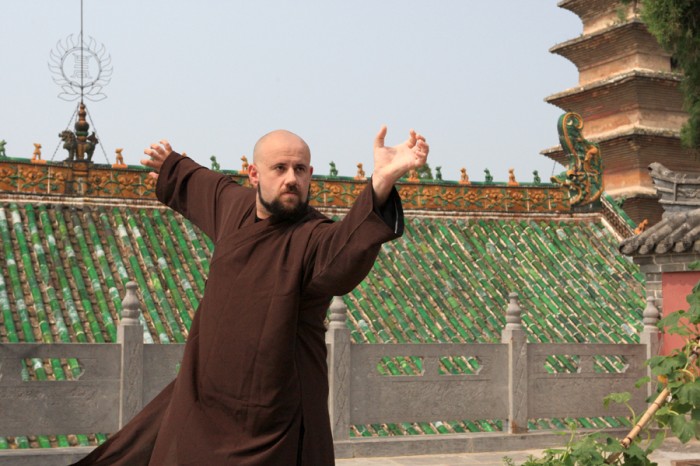套路和它们的使用
Forms and their use
We remind you that this website is subject to Disclaimer and Intellectual Property Rights.PLEASE READ CAREFULLY THE TERMS OF USE BEFORE YOU USE OUR WEBSITE ["shaolin.org.gr"]
Publication Date: 08/17/2015
Published by: «EPOS» Information and Public Relations Office
The term Forms means the combination of several techniques, organized by their initiators, in order to present their experience and knowledge from a real battle and which they can pass on to future generations. Masters that created the Forms which have reached to this day, were perfectly aware of the styles, were experienced in the techniques, in order to be able to see the advantages and disadvantages of the form, the techniques, the sequence of footsteps and the technical maneuvers.
In each form there are multiple levels of techniques and certainly much more hidden from non-experienced students or Masters. Although there are hundreds of possible combinations and applications of techniques in a form, that only our imagination can define, most Forms have at least three basic levels of application, unless they are specifically applicable for power or breathing.
The first level is the simplest and most obvious application of the moves that generally contain the fundamental techniques of each style.
The second level is probably the substance of each style. The techniques of the form at this level require more interpretation, analysis and very detailed explanation from the Master, and often include more techniques than those performed in the basic teaching of the form and different paces and positions.
The third level is a bit deeper and not as clear to understand and requires an experienced Master, in order to understand the true essence of the technique applications and the kinesiology of the form. It emphasizes the strength, the combination of movement with breathing and the use of internal energy, while it improves positions combined with paces and maneuvering.
Once you understand what are the Forms, what criteria they were created with and the levels of their teaching and implementation, we arrive at the most obvious question that is posed by many. Why should we practice the forms, dedicating so much time and effort?
In fact the forms:
1. Preserve the true essence of each style and techniques as they were taught by the original Masters who inspired them, thus forming a medium in which the principles of the style, its techniques and understanding, can pass on from generation to generation.
2. They train the practitioner in the methods and techniques that are unique to each style. As the student is practicing on a regular basis, begins to create a solid foundation and develop the required energy that is unique to each style.
3. They help us build patience and understanding, since most forms are difficult to learn and require a lot of time to understand, while they develop strength and power.
4. They help students to develop proper intention, after beginning to understand exactly what they do with one or more imaginary opponents. They begin to add more realism to the movements and techniques, that really give life to the form and make it very effective. As a student begins to understand how to perform the techniques in the form with the correct strength, breathing and balance, the form begins to acquire its own substance. Here is where the role of the Master is necessary to ensure that the substance that the form acquires, is the one that Creator Masters had originally invented and taught.
5. They teach students expressions, gestures, movements and techniques that distinguish one style from another, therefore, each style has its own shape and features that make it unique.
6. They develop character. This is perhaps the most valuable use of the forms, but it is often overlooked and underestimated by students and other. This is the section that builds strength, speed, endurance, agility, coordination, flexibility, proper breathing, as well as uniform distribution of the vital energy throughout the body.
Shaolin Kung Fu is practiced for more than 1,500 years and if there was a better way to transfer techniques, philosophy, energy and understanding of a style by the great Masters of the past, except the Forms, it would certainly have been found. For this and for the reasons above, it is important that students treat each form as a priceless historical heritage.
"Shaolin Wu Gong - The Martial Arts of Shaolin Temple "
VOLUME 1 | ISBN: 978-618-80566-3-3
Posted by Author's permission
Tags:
China, Chinese Kung Fu, Kung Fu, Kung Fu Grading, Martial Arts, Chinese Martial Arts, Shaolin, Shaolin Kung Fu, shaolin kung fu grading, shaolin temple, Shifu Shi Yan Zhuo, Changchun Wushu CenterA Friendly Reminder: All content included on this site, such as text, graphics, logos, button icons, images, audio clips, and software, is the property of Hellenic Shaolin Cultural Center or its content suppliers and protected by US and International Copyright Laws. The compilation (meaning the collection, arrangement, and assembly) of all content on this site is the exclusive property of Hellenic Shaolin Cultural Center and protected by US and International Copyright Laws. Any use of the content on this site, including the reproduction, modification, distribution, transmission, republication, display, or performance, is strictly prohibited.

